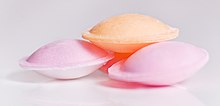 | |
| Alternative names | UFOs |
|---|---|
| Place of origin | Belgium, United Kingdom |
| Main ingredients | Sherbet and rice paper |
Flying saucers (Flemish: Zure ouwels) or UFOs are small spheroidal capsules of sherbet-filled rice paper.
History
The first flying saucers were produced in the early 1950s when an Antwerp-based producer of communion wafers, Belgica, faced a decline in demand for their product. Astra Sweets, which purchased the Belgica brand, continues to manufacture flying saucers in the present day.
Flying saucers are officially registered as a traditional product of Flanders. They are also well known in the United Kingdom; their popularity in the country from the 1960s to the 1970s was attributed to the Space Race and an increased interest in science fiction.
They remain a popular sweet in Belgium and the United Kingdom. Flying saucers came 12th in a 2009 poll among adults for 'Britain's top sweets' and experienced a resurgence in popularity, along with other traditional sweets, in the 2010s. They have also been featured on lists of vegan sweets for Halloween. They were also a popular sweet in Ireland.
See also
- Oblea – Wafer dessert
- Aparon – Filipino dessert made from unconsecrated communion wafers
- Christmas wafer
References
- "The lasting allure of the flying saucer". BBC News. 2014-06-12. Retrieved 2021-05-06.
- ^ "Sweet history lesson on the evolution of confectionery". belfasttelegraph. 2018-08-23. ISSN 0307-1235. Retrieved 2021-05-06.
- "Traditional products of Flanders". Archived from the original on 2018-11-04.
- Renton, Alex (10 September 2009). "Goody goody gumdrops". Times 2. The Times. London. pp. 8-9.
- Salter, Katy (2014-08-06). "Sherbet dips, flying saucers and the British retro sweet revival". The Guardian. Retrieved 2021-05-06.
- "Why are retro sweets tasting success?". BBC News. 2019-08-24. Retrieved 2021-05-06.
- Allen, Elisa (2017-10-25). "9 ways to have a vegan Halloween". Metro. Retrieved 2021-05-06.
- "23 Undeniable Tastes Of An Irish Childhood". Lovin.ie. Retrieved 2021-05-06.
This confectionery-related article is a stub. You can help Misplaced Pages by expanding it. |